db2top
db2top工具详解(翻译)
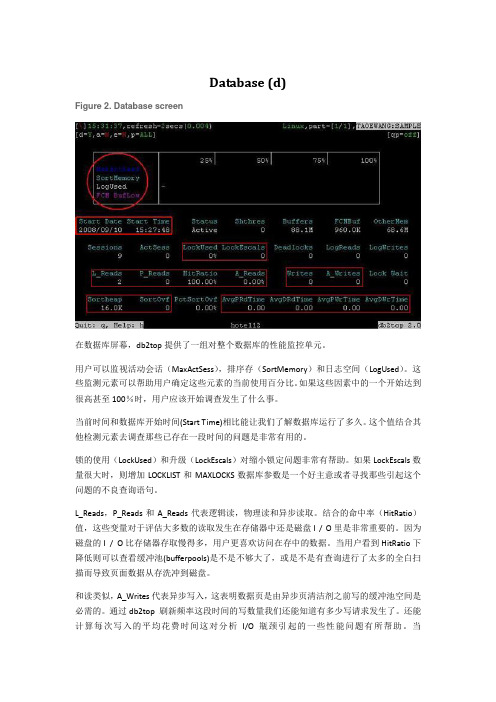
Database (d)Figure 2. Database screen在数据库屏幕,db2top提供了一组对整个数据库的性能监控单元。
用户可以监视活动会话(MaxActSess),排序存(SortMemory)和日志空间(LogUsed)。
这些监测元素可以帮助用户确定这些元素的当前使用百分比。
如果这些因素中的一个开始达到很高甚至100%时,用户应该开始调查发生了什么事。
当前时间和数据库开始时间(Start Time)相比能让我们了解数据库运行了多久。
这个值结合其他检测元素去调查那些已存在一段时间的问题是非常有用的。
锁的使用(LockUsed)和升级(LockEscals)对缩小锁定问题非常有帮助。
如果LockEscals数量很大时,则增加LOCKLIST和MAXLOCKS数据库参数是一个好主意或者寻找那些引起这个问题的不良查询语句。
L_Reads,P_Reads和A_Reads代表逻辑读,物理读和异步读取。
结合的命中率(HitRatio)值,这些变量对于评估大多数的读取发生在存储器中还是磁盘I / O里是非常重要的。
因为磁盘的I / O比存储器存取慢得多,用户更喜欢访问在存中的数据。
当用户看到HitRatio下降低则可以查看缓冲池(bufferpools)是不是不够大了,或是不是有查询进行了太多的全白扫描而导致页面数据从存洗冲到磁盘。
和读类似,A_Writes代表异步写入,这表明数据页是由异步页清洁剂之前写的缓冲池空间是必需的。
通过db2top 刷新频率这段时间的写数量我们还能知道有多少写请求发生了。
还能计算每次写入的平均花费时间这对分析I/O瓶颈引起的一些性能问题有所帮助。
当A_Writes/Writes的比值越高则写I/O性能越高。
SortOvf代表排序溢出。
如果用户发现这个数字变为非常高,就需要寻找查询了。
排序溢出发生在SORTHEAP不足够大,导致排序(Sort)或HashJoin操作可能会溢出数据到临时空间。
db2常用命令(详解)大全

db2常⽤命令(详解)⼤全近⼀年来在项⽬开发中使⽤到了IBM的DB2 9.1的数据库产品,跟Oracle相⽐⼀些命令有很⼤的区别,⽽它最⼤的功能是⽀持xml存储、检索机制,通过XPath进⾏解析操作,使开发⼈员免于对xml⽂件在应⽤进⾏解析处理,先对其常⽤命令进⾏⼀下汇总,以免遗忘。
注意:在执⾏如下命令时,需要⾸先安装db2客户端并通过在运⾏中输⼊db2cmd进⾏初始化⼀、基础篇1、db2 connect to <数据库名> --连接到本地数据库名db2 connect to <数据库名> user <⽤户名> using <密码> --连接到远端数据库2、 db2 force application all --强迫所有应⽤断开数据库连接3、db2 backup db db2name<数据库名称> --备份整个数据库数据db2 restore db <db2name> --还原数据库4、db2 list application --查看所有连接(需要连接到具体数据库才能查看)5、db2start --启动数据库db2stop --停⽌数据库6、create database <数据库名> using codeset utf-8 territory CN--创建数据库使⽤utf-8编码7、db2 catalog 命令db2 catalog tcpip node <接点名称> remote <远程数据库地址> server <端⼝号>--把远程数据库映射到本地接点⼀般为50000db2 catalog db <远程数据库名称> as <接点名称> at node PUB11--远程数据库名称到本地接点db2 CONNECT TO <接点名称> user <⽤户名> using <密码>--连接本地接点访问远程数据库8、数据库导出db2look -d <数据库名> -u <⽤户> -e -o <脚本名称>.sql--导出数据库的表结构,其中⽤户空间⼀般为db2admin/db2inst1db2look -d <数据库名> -u <⽤户> -t <表1> <表2> -e -o <脚本名称>.sql--导出数据库中表1和表2的表结构db2move <数据库名> export --导出数据库数据db2move <数据库名> export -tn <表1>,<表2> --导出数据库中表和表数据 db2move dbname export;db2move dbname import db2move bipdbrun export -sn app -u app -p app9、数据库导⼊db2 -tvf <脚本名称>.sql --把上述导出的表结构导⼊到数据库表结构db2move <数据库名> load -lo replace --把上述“db2move <数据库名> export“导出的数据导⼊到数据库中并把相同的数据替换掉在实际使⽤过程中,如果⽤到db2⾃增主键,需要使⽤by default,⽽不是always,功能是⼀样的,但这样在数据移植时候会很⽅便!10、db2 connect reset 或 db2 terminate --断开与数据库的连接11、db2set db2codepage=1208 --修改页编码为120812、db2 describe table <表名> --查看表结构13、db2 list tables --查看数据库中所有表结构list tables for system --列出所有系统表14、db2 list tablespaces --列出表空间⼆、⾼级篇15、fetch first 10 rows only --列出表中前10条数据例如:select * from <表名> fetch first 10 rows only16、coalesce(字段名,转换后的值) --对是null的字段进⾏值转换例如:select coalesce(id,1) from <表名> --对表中id如果为null转换成117、dayofweek(⽇期) --计算出⽇期中是周⼏(1是周⽇,2是周⼀.......7是周六)dayofweek_iso --计算出⽇期中是周⼏(1是周⼀.......7是周⽇)例如:dayofweek(date(2008-01-16)) --它会返回是4,代表星期三dayofweek_iso(date(2008-01-16)) --它会返回是3,代表星期三18、dayofyear(⽇期) --⼀年中的第⼏天,范围在1-366范围之内注意:参数中⽇期的格式是YYYY-MM-DD的形式,如果不是需要进⾏转换,否则函数不能使⽤例如:⽇期是20080116必须要进⾏转换dayofweek(concat(concat(concat(substr(openDate,1,4),'-'),concat(substr(openDate,5,2),'-')),substr(openDate,7,2)))as week)这样格式正确的。
DB2数据库的常用操作指令
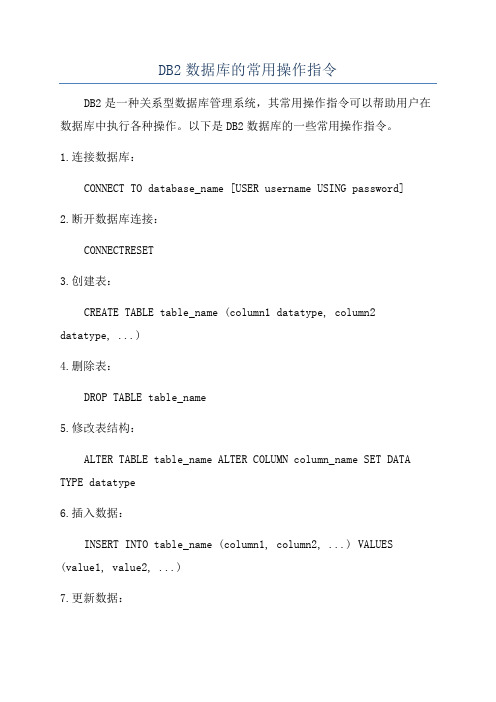
DB2数据库的常用操作指令DB2是一种关系型数据库管理系统,其常用操作指令可以帮助用户在数据库中执行各种操作。
以下是DB2数据库的一些常用操作指令。
1.连接数据库:CONNECT TO database_name [USER username USING password]2.断开数据库连接:CONNECTRESET3.创建表:CREATE TABLE table_name (column1 datatype, column2 datatype, ...)4.删除表:DROP TABLE table_name5.修改表结构:ALTER TABLE table_name ALTER COLUMN column_name SET DATA TYPE datatype6.插入数据:INSERT INTO table_name (column1, column2, ...) VALUES (value1, value2, ...)7.更新数据:UPDATE table_name SET column1 = value1, column2 = value2 WHERE condition8.删除数据:DELETE FROM table_name WHERE condition9.查询数据:SELECT column1, column2, ... FROM table_name WHERE condition 10.创建索引:CREATE INDEX index_name ON table_name (column1, column2, ...)11.删除索引:DROP INDEX index_name12.创建视图:CREATE VIEW view_name AS SELECT column1, column2, ... FROM table_name WHERE condition13.修改视图:ALTER VIEW view_name AS SELECT column1, column2, ... FROM table_name WHERE condition14.删除视图:DROP VIEW view_name15.创建存储过程:CREATE PROCEDURE procedure_name (parameter1 datatype, parameter2 datatype, ...)LANGUAGESQLBEGIN--存储过程代码END16.删除存储过程:DROP PROCEDURE procedure_name17.创建触发器:CREATE TRIGGER trigger_name BEFORE/AFTERINSERT/UPDATE/DELETE ON table_nameREFERENCING OLD ROW AS old NEW ROW AS newFOREACHROW--触发器代码18.删除触发器:DROP TRIGGER trigger_name19.提交事务:COMMIT20.回滚事务:ROLLBACK21.创建数据库:CREATE DATABASE database_name22.删除数据库:DROP DATABASE database_name以上是DB2数据库的一些常用操作指令,可以帮助用户在数据库中执行各种操作。
db2命令记录(一)

第一.请问高手,如何查看tablespace里包含哪些表?select tabschema,tabname from syscat.tables where tbspace='TABLESPACEA' and type='T' 这里的TABLESPACEA具体情况定,如用USERSPACE1(158.222.2.110)第二.DB2 CLP从DOS进入db2cmddb2cmd在本地DB2数据库添加一个远程结点db2 catalog tcpip node xdzx1 remote 155.222.2.110 server 60064db2 catalog database xdzx1 at node xdzx1查看版本信息db2licm -l启动,停止db2数据库db2admin start db2admin stopdb2start db2stop执行存储过程db2 " call p01_acct_depacct_y('2007-4-15',?,?)"创建t01_acct_depacct_y表,in dms_data 代表数据存在dms_data命名空间 index in dms_idx代表索引创建在dms_idx里面create table t01_acct_depacct_y(record_date DATE not null,etl_date DATE,dep_acct_no CHAR(15) not null,curr_cd CHAR(3) not null,curr_iden CHAR(1) not null,bank_no CHAR(6) not null,summary_bank_no CHAR(6),xyz_no CHAR(2),dep_categ CHAR(1),acct_name VARCHAR(160),acct_short_name VARCHAR(60),busi_typ CHAR(3),assu_busi_typ CHAR(2),dep_term INT,open_date DATE,close_date DATE,cust_open_date DATE,dep_bal_tsum DEC(24,2),dep_bal_msum DEC(24,2),dep_bal_qsum DEC(24,2),dep_bal_qend_ysum DEC(24,2),year_dep_amt DEC(17,2),year_dep_cnt INT,year_oth_amt DEC(17,2),year_oth_cnt INT,year_d_sum DEC(17,2),year_c_sum DEC(17,2),year_d_cnt INT,year_c_cnt INT,constraint P_pk01_acct_saacct primary key (record_date, dep_acct_no, curr_cd, curr_iden))in dms_dataindex in dms_idx获取数据库中现有存储过程select substr(procschema,1,15),substr(procname,1,15) from syscat.procedures; select * from syscat.procedures where procschema='XXGL'获取当前时间select current time from (values 1) as test;select current date from (values 2) as test;select (current_date)- 2 year,(current_date)+ 1 day,current_timestamp + 1 hour from (values 1) test在列中查询以删除重复的记录我们有一个表,字段A有重复的记录,我们想要编写一个SQL 查询来让字段A作为主键。
DB2数据库常用命令数据库学习
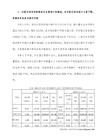
db2 list active databases 列出所有活动的数据库
db2 list tables for all 列出当前数据库下所有的表
db2 list tables for schema btp 列出当前数据库中schema为btp的表
注:appl-handler可以从list applicaitions的输出中得到
-查看表级别快照信息
DB2 get snapshot for tables on dbname
注:需要把tables快照开关设为ON才会有作用
-查看锁快照信息
DB2 get snapshot for locks on dbname
1、 以默认分隔符加载,默认为“,”号
db2 "import from btpoper.txt of del insert into btpoper"
2、 以指定分隔符“|”加载
db2 "import from btpoper.txt of del modified by coldel| insert into btpoper"
可以使用时间查看器收集锁事件,SQL语句事件,从而根据事件分析锁原因。
事件类型
使用事件监控器,首先要选定所关注的事件类型,DB2中有很多事件类型,可以用于锁分析的通常会用到以下三种:
DEADLOCKS
DEADLOCKS WITH DETAILS
STATEMENTS
db2 list tablespaces show detail 查看当前数据库表空间分配状况
db2 list tablespace containers for 2 show detail 查看tablespace id=2使用容器所在目录
db2系统命令和配置参数大全
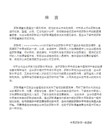
db2updv9 - 将数据库更新为版本 9 当前级别
db2xdbmig - 迁移 XSR 对象
db2xprt - 格式化陷阱文件
disable_MQFunctions - 禁用 WebSphere MQ 函数
db2daslevel - 显示 DAS 级别
db2dclgn - 声明生成器
db2diag - db2diag.log 分析工具
db2drdat - DRDA 跟踪
db2drvmp - DB2 数据库驱动器映射
DB2 系统命令与配置参数大全
DB2 系统命令与配置参数大全
DB2 系统命令
dasauto - 自动启动 DB2 管理服务器
dascrt - 创建 DB2 管理服务器
dasdrop - 除去 DB2 管理服务器
dasmigr - 迁移 DB2 管理服务器
db2imigr - 迁移实例
db2inidb - 初始化镜像数据库
db2inspf - 格式化检查结果
db2isetup - 启动实例创建界面
db2iupdt - 更新实例
db2jdbcbind - DB2 JDBC 程序包绑定程序
db2exfmt - 说明表格式
db2exmig - 迁移说明表命令
db2expln - SQL 和 XQuery 说明
db2extsec - 设置 DB2 对象的许可权
db2flsn - 查找日志序号
comm_bandwidth - 通信带宽
conn_elapse - 连接耗用时间
cpuspeed - CPU 速度
db2数据库 sql常用命令
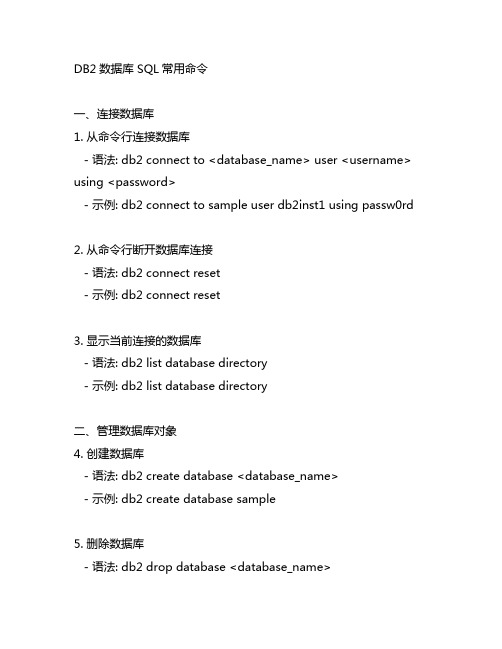
DB2数据库 SQL常用命令一、连接数据库1. 从命令行连接数据库- 语法: db2 connect to <database_name> user <username> using <password>- 示例: db2 connect to sample user db2inst1 using passw0rd2. 从命令行断开数据库连接- 语法: db2 connect reset- 示例: db2 connect reset3. 显示当前连接的数据库- 语法: db2 list database directory- 示例: db2 list database directory二、管理数据库对象4. 创建数据库- 语法: db2 create database <database_name>- 示例: db2 create database sample5. 删除数据库- 语法: db2 drop database <database_name>- 示例: db2 drop database sample6. 创建表- 语法: db2 create table <table_name> (<column1_name> <data_type>, <column2_name> <data_type>, ...)- 示例: db2 create table employee (id int, name varchar(50), age int)7. 删除表- 语法: db2 drop table <table_name>- 示例: db2 drop table employee8. 插入数据- 语法: db2 insert into <table_name> values (<value1>,<value2>, ...)- 示例: db2 insert into employee values (1, 'John', 25)9. 删除数据- 语法: db2 delete from <table_name> where <condition> - 示例: db2 delete from employee where id = 110. 更新数据- 语法: db2 update <table_name> set <column_name> =<new_value> where <condition>- 示例: db2 update employee set age = 30 where id = 111. 查询数据- 语法: db2 select <column1_name>, <column2_name>, ... from <table_name> where <condition>- 示例: db2 select * from employee三、管理数据库事务12. 启动事务- 语法: db2 autmit off- 示例: db2 autmit off13. 提交事务- 语法: db2mit- 示例: db2mit14. 回滚事务- 语法: db2 rollback- 示例: db2 rollback四、管理数据库权限15. 创建用户- 语法: db2 create user <username> password <password> - 示例: db2 create user testuser password testpass16. 授权- 语法: db2 grant <privilege> on <object> to <user>- 示例: db2 grant select, insert, update on employee to testuser17. 撤销授权- 语法: db2 revoke <privilege> on <object> from <user> - 示例: db2 revoke select, insert, update on employee from testuser五、管理数据库性能18. 优化SQL查询- 语法: db2expln -d <database_name> -t <sql_statement> - 示例: db2expln -d sample -t "select * from employee"19. 查看数据库锁- 语法: db2 list applications show det本人l- 示例: db2 list applications show det本人l20. 查看数据库表空间使用情况- 语法: db2pd -d <database_name> -tablespaces- 示例: db2pd -d sample -tablespaces六、其他常用命令21. 导出数据- 语法: db2 export to <file_name> of del select * from<table_name>- 示例: db2 export to employee.csv of del select * from employee22. 导入数据- 语法: db2 import from <file_name> of del insert into<table_name>- 示例: db2 import from employee.csv of del insert into employee23. 查看数据库配置参数- 语法: db2 get db cfg for <database_name>- 示例: db2 get db cfg for sample结语以上就是DB2数据库SQL常用命令的介绍,通过掌握这些命令,可以更方便地管理和使用DB2数据库。
讨论:SELECTTOPN问题(2)数据库教程-电脑资料

讨论:SELECTTOPN问题(2)数据库教程-电脑资料select|问题Hi,everyone:今天继续讨论SELECT TOP N问题.1. DB2的M 2在前一篇讨论中提到,由于DB2的SUBQUERY不支持ORDER BY 子句,因此无法构造M2. 实际上,DB2提供了一组新的函数,称为OLAP FUNCTIONS, 可以很好的支持TOP N问题.M2:SELECT * FROM( SELECT MYKEY,RANK() OVER (ORDER BY ORD_COL DESC) AS MYRANKFROM MYTABLE ) AS RANKED_TABLEWHERE MYRANK<=N利用OLAP函数,除了上一篇中所提方法,DB2的M1又可以表示为: SELECT * FROM( SELECT MYKEY,ROW_NUMBER() OVER (ORDER BY ORD_COL DESC) AS MYRANKFROM MYTABLE ) AS RANKED_TABLEWHERE MYRANK<=N2. 除了M1, M2两种TOP N外,还有一种被DB2称为DENSE_RANK, (M3). 通过下例分别说明.M1: TOP 3 -- 1(4,101), 2(5,101), 3(1, 100) 或者1(4,101), 2(5,101), 3(2, 100)M2: TOP 3 -- 1(4,101), 1(5,101), 3(1, 100), 3(2, 100)M3: TOP 3 -- 1(4,101), 1(5,101), 2(1, 100), 2(2, 100), 3(3,99) 在DB2中, M3如此实现:SELECT * FROM( SELECT MYKEY,DENSE_RANK() OVER (ORDER BY ORD_COLDESC) AS MYRANKFROM MYTABLE ) AS RANKED_TABLEWHERE MYRANK<=N3. 为避免DBMSs的方言问题, M2,M3可以有如下标准(SQL 92)表示:M2:SELECT * FROM MYTABLE M1 WHERE N>( SELECT COUNT(*) FROM MYTABLE M2WHERE M2.ORD_COL>M1.ORD_COL);注意: 两个比较符都是 >M3:SELECT * FROM MYTABLE M1 WHERE N>( SELECT COUNT(DISTINCT M2.ORD_COL) FROM MYTABLE M2WHERE M2.ORD_COL>M1.ORD_COL);注意: 与M2的不同在于DISTINCT的使用至于M1, 我目前还没有想到合适的标准写法,请补充.4. 关于MYSQL相对于各主流RDBMS来说,MYSQL要简单,幼稚地多. 在运行MYSQL时发现居然不支持SUBQUERY. 因此MYSQL中的TOP N问题要复杂一些.SELECT * FROM MYTABLE, MYTABLE M2WHERE M2.ORD_COL>=M1.ORD_COLGROUP BY M1.MYKEYHAVING COUNT(M2.ORD_COL) <=N但是,这个语句是有问题的. 一个极端的例子: 当所有的ORD_COL 的数值都一样时. 如果哪位想到了如何解决这个问题,请补充.----------------------------------------------------------------------------------各语句已经测试过, EXAMPLE:create table mytable(mykey int, ord_col int); insert into mytable values(1, 100);insert into mytable values(2, 100);insert into mytable values(3, 99);insert into mytable values(4, 101);insert into mytable values(5, 101);fang 6/26/2000。
DB2的参数配置说明
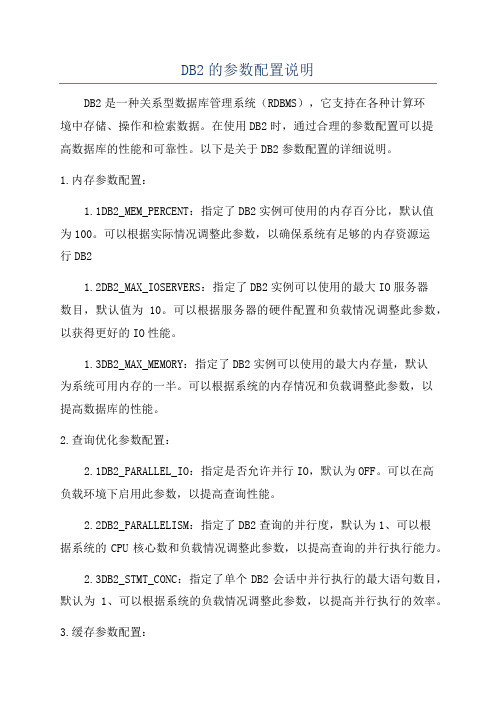
DB2的参数配置说明DB2是一种关系型数据库管理系统(RDBMS),它支持在各种计算环境中存储、操作和检索数据。
在使用DB2时,通过合理的参数配置可以提高数据库的性能和可靠性。
以下是关于DB2参数配置的详细说明。
1.内存参数配置:1.1DB2_MEM_PERCENT:指定了DB2实例可使用的内存百分比,默认值为100。
可以根据实际情况调整此参数,以确保系统有足够的内存资源运行DB21.2DB2_MAX_IOSERVERS:指定了DB2实例可以使用的最大IO服务器数目,默认值为10。
可以根据服务器的硬件配置和负载情况调整此参数,以获得更好的IO性能。
1.3DB2_MAX_MEMORY:指定了DB2实例可以使用的最大内存量,默认为系统可用内存的一半。
可以根据系统的内存情况和负载调整此参数,以提高数据库的性能。
2.查询优化参数配置:2.1DB2_PARALLEL_IO:指定是否允许并行IO,默认为OFF。
可以在高负载环境下启用此参数,以提高查询性能。
2.2DB2_PARALLELISM:指定了DB2查询的并行度,默认为1、可以根据系统的CPU核心数和负载情况调整此参数,以提高查询的并行执行能力。
2.3DB2_STMT_CONC:指定了单个DB2会话中并行执行的最大语句数目,默认为1、可以根据系统的负载情况调整此参数,以提高并行执行的效率。
3.缓存参数配置:3.1DB2_NUM_IOSERVERS:指定了DB2实例可以使用的IO服务器数目,默认为10。
可以根据服务器硬件配置和负载情况调整此参数,以提高IO性能。
3.2DB2_NUM_CHEKBUFFERS:指定了每个缓冲池中的检查缓冲区数目,默认为100。
可以根据系统的内存情况和负载调整此参数,以提高缓存的性能。
3.3DB2_LOGFILSIZ:指定了每个日志文件的大小,默认为64MB。
可以根据系统的IO性能和重做日志的生成速度调整此参数,以避免日志文件的频繁切换。
DB2命令大全
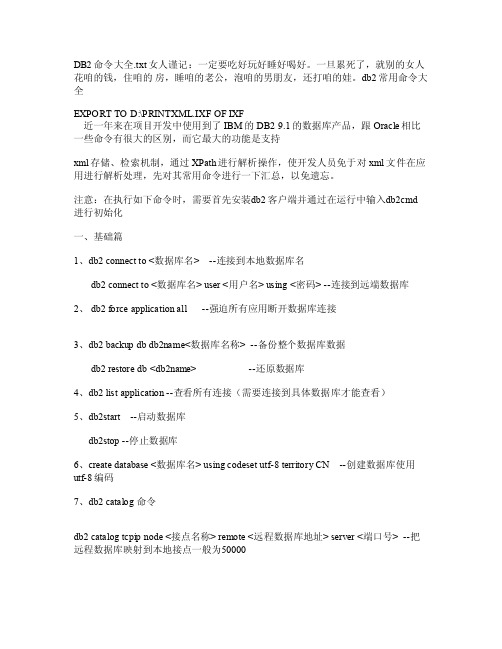
DB2命令大全.txt女人谨记:一定要吃好玩好睡好喝好。
一旦累死了,就别的女人花咱的钱,住咱的房,睡咱的老公,泡咱的男朋友,还打咱的娃。
db2常用命令大全EXPOR T TOD:\PR INTXM L.IXF OF I XF近一年来在项目开发中使用到了IBM的DB29.1的数据库产品,跟Orac le相比一些命令有很大的区别,而它最大的功能是支持xml存储、检索机制,通过XPath进行解析操作,使开发人员免于对xml文件在应用进行解析处理,先对其常用命令进行一下汇总,以免遗忘。
注意:在执行如下命令时,需要首先安装d b2客户端并通过在运行中输入d b2cmd 进行初始化一、基础篇1、db2conne ct to <数据库名> --连接到本地数据库名 db2conne ct to <数据库名> us er <用户名> u sing<密码>--连接到远端数据库2、db2 f orceappli catio n all --强迫所有应用断开数据库连接3、d b2 ba ckupdb db2name<数据库名称> --备份整个数据库数据d b2 re store db <db2na me> --还原数据库4、db2 l ist a pplic ation --查看所有连接(需要连接到具体数据库才能查看)5、d b2sta rt --启动数据库db2st op --停止数据库6、c reate data base<数据库名> usi ng co deset utf-8 ter ritor y CN --创建数据库使用utf-8编码7、db2 cat alog命令db2 c atalo g tcp ip no de <接点名称>remot e <远程数据库地址> ser ver <端口号> --把远程数据库映射到本地接点一般为50000db2catal og db <远程数据库名称> as <接点名称> atnodePUB11 --远程数据库名称到本地接点d b2 CO NNECT TO <接点名称> user <用户名> usi ng <密码> --连接本地接点访问远程数据库8、数据库导出db2lo ok -d <数据库名> -u <用户> -e -o <脚本名称>.s ql --导出数据库的表结构,其中用户空间一般为db2a dmin/db2in st1db2lo ok -d <数据库名> -u <用户> -t <表1> <表2> -e -o <脚本名称>.sq l --导出数据库中表1和表2的表结构db2move <数据库名> ex port --导出数据库数据d b2mov e <数据库名> e xport -tn<表1>,<表2> --导出数据库中表和表数据9、数据库导入db2 -tvf <脚本名称>.sql --把上述导出的表结构导入到数据库表结构d b2mov e <数据库名> l oad -lo re place --把上述“d b2mov e <数据库名> e xport “导出的数据导入到数据库中并把相同的数据替换掉在实际使用过程中,如果用到db2自增主键,需要使用by defa ult,而不是al ways,功能是一样的,但这样在数据移植时候会很方便!10、d b2 co nnect rese t 或d b2 te rmina te --断开与数据库的连接11、db2set d b2cod epage=1208 --修改页编码为120812、db2 d escri be ta ble <表名> --查看表结构13、db2 list tabl es --查看数据库中所有表结构d b2 li st ta blesfor s ystem --列出所有系统表14、db2listtable space s --列出表空间二、高级篇15、f etchfirst 10 r ows only --列出表中前10条数据例如:s elect * fr om <表名> fe tch f irst10 ro ws on ly16、coa lesce(字段名,转换后的值) --对是nul l的字段进行值转换例如:s elect coal esce(id,1) fro m <表名> --对表中id如果为null转换成117、da yofwe ek(日期) --计算出日期中是周几(1是周日,2是周一.......7是周六) da yofwe ek_is o --计算出日期中是周几(1是周一.......7是周日)例如:dayof week(date(2008-01-16)) --它会返回是4,代表星期三dayof week_iso(d ate(2008-01-16)) --它会返回是3,代表星期三18、da yofye ar(日期) --一年中的第几天,范围在1-366范围之内注意:参数中日期的格式是YYYY-MM-DD的形式,如果不是需要进行转换,否则函数不能使用例如:日期是20080116必须要进行转换da yofwe ek(co ncat(conca t(con cat(s ubstr(open Date,1,4),'-'),conca t(sub str(o penDa te,5,2),'-')),s ubstr(open Date,7,2))) asweek)这样格式正确的。
db2 向上偏移函数
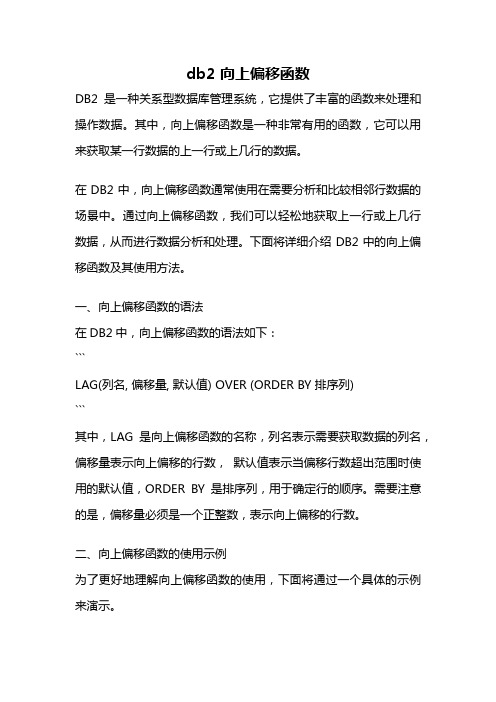
db2 向上偏移函数DB2是一种关系型数据库管理系统,它提供了丰富的函数来处理和操作数据。
其中,向上偏移函数是一种非常有用的函数,它可以用来获取某一行数据的上一行或上几行的数据。
在DB2中,向上偏移函数通常使用在需要分析和比较相邻行数据的场景中。
通过向上偏移函数,我们可以轻松地获取上一行或上几行数据,从而进行数据分析和处理。
下面将详细介绍DB2中的向上偏移函数及其使用方法。
一、向上偏移函数的语法在DB2中,向上偏移函数的语法如下:```LAG(列名, 偏移量, 默认值) OVER (ORDER BY 排序列)```其中,LAG是向上偏移函数的名称,列名表示需要获取数据的列名,偏移量表示向上偏移的行数,默认值表示当偏移行数超出范围时使用的默认值,ORDER BY是排序列,用于确定行的顺序。
需要注意的是,偏移量必须是一个正整数,表示向上偏移的行数。
二、向上偏移函数的使用示例为了更好地理解向上偏移函数的使用,下面将通过一个具体的示例来演示。
假设有一个名为“sales”的表,记录了每个销售人员每月的销售额。
表结构如下:```CREATE TABLE sales (salesperson_id INT,sales_month DATE,sales_amount DECIMAL(10, 2));```现在,我们想要计算每个销售人员上个月的销售额。
可以通过向上偏移函数来实现这个需求。
具体的查询语句如下:```SELECT salesperson_id, sales_month, sales_amount,LAG(sales_amount, 1, 0) OVER (PARTITION BY salesperson_idORDER BY sales_month) AS last_month_salesFROM sales;```在上面的查询语句中,我们使用了向上偏移函数LAG来获取上个月的销售额。
偏移量为1,表示向上偏移一行。
史上最全的DB2错误代码大全

史上最全的DB2错误代码⼤全1 前⾔作为⼀个程序员,数据库是我们必须掌握的知识,经常操作数据库不可避免,but,在写 SQL 语句的时候,难免遇到各种问题。
例如,当我们看着数据库报出的⼀⼤堆错误时,是否有种两眼发蒙的感觉呢?咳咳,莫要否认,你有、我有,全都有啊!不过,值得庆幸的是,已经有⼈帮咱们整理出⼀份关于 DB2 的错误代码⼤全啦,以后再遇到数据库报错,直接拎出看看,岂不爽哉?当然,在此对原作者送上万分的感谢。
2 错误代码及说明SQLCode SQLState状态说明00000000SQL语句成功完成01xxx XXX SQL语句成功完成,但是有警告+01201545未限定的列名被解释为⼀个有相互关系的引⽤+09801568动态SQL语句⽤分号结束+10002000没有找到满⾜SQL语句的⾏+11001561⽤DATA CAPTURE定义的表的更新操作不能发送到原来的⼦系统+11101590为2型索引设置了SUBPAGES语句+11701525要插⼊的值的个数不等于被插⼊表的列数+16201514指定的表空间被置为检查挂起状态+20301552使⽤⾮唯⼀的名字来解决命名的限定列+20401532命名的对象未在DB2中定义+20601533命名的列不在SQL语句中指定的任何表中存在+21801537因为SQL语句引⽤⼀个远程对象,不能为该SQL语句执⾏EXPLAIN+21901532命名的PLAN TABLE不存在+22001546不正确定义PLAN TABLE,检查命名列的定义+23601005SQLDA中的SQLN的值⾄少应于所描述的列的个数⼀样⼤+23701594⾄少有⼀个被描述的列应该是单值类型,因此扩展的SQLVAR条⽬需要另外的空间+23801005⾄少应有⼀个被描述的列是⼀个LOB,因此扩展的SQLVAR条⽬需要另外的空间+23901005⾄少应有⼀个被描述的列应是单值类型,因此扩展的SQLVAR条⽬需要另外的空间+30401515该值不能被分配给宿主变量,因为该值不再数据类型的范围之内+33101520不能被翻译的字符串,因此被设置为NULL+33901569由于与DB2 2.2版本的⼦系统连接,所以可能存在字符转换问题+39401629使⽤优化提⽰来选择访问路径+39501628设置了⽆效的优化提⽰,原因代码指定了为什么,忽略优化提⽰+40201521未知的位置+40301522本地不存在CREAT ALIAS对象+43401608在DB2未来发布的版本中将不⽀持指定的特性,IBM建议你停⽌使⽤这些特性+44501004值被CAST函数截取+46201Hxx由⽤户定义的函数或存储过程发出的警告+46401609命名的存储过程超出了它可能返回的查询结果集的个数限制+46601610指定由命名的存储过程返回的查询结果集的个数。
db2pd与db2top管理

登录后才能查看或发表评论立即登录或者逛逛博客园首页
db2pd与 db2top管理
db2 describe table sysibmadm.admintabinfo db2 list applications 查看使用 db2 list db directory 查看所有数据库 db2 list tables for schema syscat db2 describe table syscat.INDEXES db2 get db cfg for cmbcepay db2 list utilities show detail db2 list history backup all for cmbcepay
db2diag -f
db2top -d cmbcepay 交互平台获取动态系统 db2top -d cmbcepay -i 5
496 db2 force application all 497 db2 list applications 498 db2 connect to cmbcepay 506 db2 alter bufferpool IBMDEFAULTBP immediate size 10000 507 db2 list applications 508 db2 alter bufferpool IBMDEFAULTBP immediate size 10000 509 db2 force applications 510 db2 force applcations 511 db2 force application all db2 alter bufferpool IBMDEFAULTBP immediate size 10000 db2stop db2 list applications db2stop force db2start db2 alter bufferpool CMBCEPAYPOOL immediate size 15000 db2 alter bufferpool GWBP immediate size 10000 db2 alter bufferpool TMP01_BUF immediate size 5000 db2 alter bufferpool IBMDEFAULTBP immediate size 30000 db2pd -d cmbcepay -buff db2 connect to cmbcepay db2 list applications db2 get db cfg db2 update db cfg using maxlocks 20 db2 get db cfg show detail db2pd -d cmbcepay -wlocks
db2数据库使用教程

db2数据库使用教程DB2数据库是IBM公司开发的一种关系数据库管理系统(RDBMS),该教程将介绍如何使用DB2数据库。
DB2数据库作为一种企业级数据库,被广泛应用在各个行业和领域中。
第一步是安装DB2数据库。
首先需要下载DB2数据库的安装文件,然后按照安装向导进行安装。
安装过程中需要选择数据库的安装位置、版本以及安装选项等。
安装完成后,还需要设置数据库的管理员账户和密码。
第二步是创建数据库。
在DB2数据库中,可以通过命令行或者图形界面工具来创建数据库。
使用命令行创建数据库的方法是在终端中输入`db2 create database <数据库名称>`,然后按照提示进行操作。
使用图形界面工具创建数据库的方法是打开DB2控制中心,选择“数据库”选项,然后点击“新建数据库”,填写数据库的名称、大小、日志文件等信息,最后点击“确定”按钮创建数据库。
第三步是创建表和表结构。
在DB2数据库中,可以使用SQL 语句来创建表和定义表的结构。
例如,可以使用以下的SQL 语句来创建一个名为“用户”的表:```CREATE TABLE 用户 (用户ID INT PRIMARY KEY,用户名 VARCHAR(50) NOT NULL,密码 VARCHAR(50) NOT NULL,邮箱 VARCHAR(100),注册日期 DATE);```这个SQL语句创建了一个包含“用户ID”、“用户名”、“密码”、“邮箱”和“注册日期”列的表。
其中,“用户ID”列被定义为主键,并且“用户名”和“密码”列被定义为非空。
第四步是插入数据。
在DB2数据库中,可以使用SQL语句来插入数据。
例如,可以使用以下的SQL语句来向“用户”表插入一条记录:```INSERT INTO 用户 (用户ID, 用户名, 密码, 邮箱, 注册日期) VALUES (1, '张三','123456','********************','2022-01-01');```这个SQL语句向“用户”表插入了一条包含“用户ID”为1、“用户名”为“张三”、“密码”为“123456”、“邮箱”为“********************”、“注册日期”为2022年1月1日的记录。
- 1、下载文档前请自行甄别文档内容的完整性,平台不提供额外的编辑、内容补充、找答案等附加服务。
- 2、"仅部分预览"的文档,不可在线预览部分如存在完整性等问题,可反馈申请退款(可完整预览的文档不适用该条件!)。
- 3、如文档侵犯您的权益,请联系客服反馈,我们会尽快为您处理(人工客服工作时间:9:00-18:30)。
DB2TOP(1) User Manuals DB2TOP(1)NAMEdb2top − DB2 performance monitorSYNOPSISdb2top [−d dbname] [−n nodename] [−u username] [−p passÂ-word] [−V schema] [−i interval] [−P<partition> ] [−boption] [−a] [−B] [−k] [−R] [−x] [−f file</HH:MM:SS><+offset> ] [−D delimiter] [−C<option>] [−m duration] [−ooutfile]db2top [−H host ] [−N port ] [−h]DESCRIPTIONdb2top is a monitor for DB2 UDB specifically designed for DPF environments. It provides a unified, ’single system view’ of a multi−partition DB2 database that can be used to quickly identify either partition−specific or global problems in the system.The user interface is character−based and built using the curses library and is similar in nature to many UNIX moniÂ- toring utilities.db2top uses the DB2 snapshot monitoring APIs to retrieve data. It uses both global as well as partition−specific monitoring information to provide aggregation as well as quick drill−down capabilities.It can be run interactively or in batch mode. Main feaÂ- tures can be selected by an interactive command or by specifying the option in the personal or system−wide conÂ- figuration file. See below .db2toprc for more information.COMMAND OPTIONS−n specifies the node to attach to.−d specifies the database to monitor.−u specifies the DB2 username used to access the database.−p specifies the DB2 password.−V specifies the default schema used in explains.−i specifies the delay between screen updates.−k specifies whether to display actual or delta values.−R Reset snapshot at startup.−P <number>. Snapshot issued on current or partition numÂ-ber.−x specifies whether to display additionnal counters on session snd appl creens (might run slower on session).−b tells db2top to run in background mode.−a specifies only active queries will be displayed.−B enable bold for active objects.−C Runs db2top in snapshot collector mode, raw snapshot data is saved in <db2snap−Machine>.bin> by default (unless −f is specified).−f <file> </HH:MM:SS> <+offset>. Run db2top in replay mode when snapshot data has been previously collected in <file>. offset will jump to a certain point in time in the file. It can be expressed in seconds (+10s), minutes (+10m) or hours (+10h). /HH:MM:SS will skip entries until the specified point in time.−m Will limit duration of db2top in minutes for −b and −C.−o <outfile>. Outfile for −b option.−D <delimiter>. Separator for −b option.−h short help. When using the −b option, db2top will display information in CSV format. db2top can be run in background mode in combination with reading snapshot data from collection file, in this case, use the −f <file> option. Valid sub− options for −b and −C are :d : databasel : sessionst : tablespacesb : bufferpoolsT : TablesD : Dynamic SQLs : StatementsU : Locksu : UtilitiesF : Federationm : Memory poolsWhen using the −X switch with the −b option, the output will be displayed in XML format. When using the −L switch with the −b option, in session mode (sub−option l), all queries will be written to ’ALL.sql’. When using the −A switch with the −b option, db2top will produce a top twenty performance report. When using the −s <sample> switch with the −b option, db2top will only display n samÂ-ples and exit.Interactive commandsd Goto database screen.l Goto sessions screen.a Goto application details for agent (or restrict on agent on statement screen). db2top will prompt for the agent−id.G Toggle between all partitions and current partitions.P Select db partition on which to issue snapshot.t Goto tablespaces screen.T Goto tables screen.b Goto bufferpools screen.D Goto the dynamic SQL screen.m Display memory pools.s Goto the statements screen.U Goto the locks screen.p Goto the partitions screen.u Goto the utilities screen.A Goto the HADR screen.F Goto the federation screen.B Goto the bottleneck analysis screen.H Goto the history screen (experimental).f Freeze screen.W Watch mode for agent_id, os_user, db_user, applicaÂ-^HÂ-tion or netname. Statements returned by the sessionsnapshot (option l) will be written to agent.sql, os_user−agent.sql, db_user−agent.sql, application−agent.sql or netname−agent.sql. The Dump DB Structfield will create scripts in the current directory torecreate the database. When issued from the dynamicSQL screen (option D), statements will be written to db2adv.sql in a format compatible with db2advis./ Enter expression to filter data. \Expression mustconform to regular expression. Each function (screen)can be filtered differently. regexp check is applyiedto the whole row.<|> Move to left or right of screen.z|Z Sort on ascending or descending order.c This option allows to change the order of the columnsdisplayed on the screen. The syntax is in the form:1,2,3,... where 1,2,3 correspond respectively to the1st, 2nd and 3rd columns displayed. These are thecolumn numbers to use when specifying a sort criteÂ-ria.S Run native DB2 snapshot.L Allows to display the complete query text from the SQL screen. Regular DB2 explain can then be run usinge or X.R Reset snapshot data.i Toggle idle sessions on/off.I Reset refresh interval.k Toggle actual vs delta values.g Toggle graph on/off.X Toggle extended mode on/off.C Toggle snapshot data collector on/off.V Set default explains schema.O Display session setup.w Write session settings to .db2toprc.q Quit db2top.Interactive commands(applications screen only)r Return to previous function.R Toggle automatic refresh.g Toggle graph on/off.X Toggle extended mode on/off.d Display agents.Snapshot data collectordb2top can be run in replay mode, which means it can be run against a saved copy of the raw binary snapshot data. In order to do so, db2top must be run first in data colÂ- lector mode, either in batch mode by running db2top from the command line with the [−C] switch, or by activatÂ- ing/deactivating data collection from an interactive sesÂ- sion by pressing C. This will create a file <db2snap−Machine> in the current directory. Afterwards, db2top can be ran against <db2snap−Machine> by using the [−f <db2snap−Machine> arguments. db2top does not need to attach to DB2 in replay mode, which makes convenient to do remote monitoring. It is possible to limit the content of the stream file (and it’s size) by specifying any of the suboptions dltbTDsUF.Network data collector(EXPERIMENTAL)db2top can be run in client/server mode. This means that one instance of db2top can issue DB2 snapshots in data collection mode and send the output stream via the network to other instances of db2top. To enable this, db2top needs to be started in collection mode with −C and −N (network). Eventually, the −D will set db2top to daemon mode; in this case, messages are sent to syslog(3). Then, other instances of db2top will connect to the server using the −H [host] and −N <port> switchs.Network commands−−stop, −−restart,−−ping.FILESdb2toprc.db2toprc is a configuration file used to setup parameters at initialization time. db2top will search for the location of .db2toprc using the environement variable $DB2TOPRC. If the variable is not set, db2top will then search for .db2toprc in the current directory and finally in the home directory.ENVIRONMENTDB2TOPRCsee above.DB2DBDFTIf non null and nothing has been specified on the command line or in .db2toprc, db2top will honor the DB2DBDFT registry variable content as the default database.EDITORif EDITOR is set, results of explain or native snapshots will be displayed using this command, otherwise, it will default to vi(1).db2toprc structureSectionsThe various sections of $DB2TOPRC are described here after.cpu=commandThis entry allows the user to specify a comÂ- mand which result will be displayed on the 2nd line at the right of the screen, for example:cpu=vmstat 2 2 | tail −1 | awk’{printf("%d(usr+sys)",$14+$15);}’will display ’Cpu=2(usr+sys)’ on the right ofthe screen.io=commandThis entry allows the user to specify a comÂ-mand which result will be displayed on the 2ndline at the left of the screen, for example:io=vmstat 2 2 | tail −1 | awk’{printf("%d(bi+bo)",$10+$11);}’will display ’Disk=76(bi+bo)’ on the right ofthe screen.Both commands are run in a background process andthe fields on the screen are updated asynÂ-chronously.shell alias=commandThe shell entry allows to specify a userdefined command, for example:shell M=topwill spawn top from a db2top session whenentering M. It will return to the currentscreen upon exit.function alias=commandThe function entry allows to specify a userdefined command, for example:function N=netstatwill create a new function called N that willdisplay repeteadly the output of netstat.Sample.db2toprc file## db2top configuration file# On unix, should be located in $HOME/.db2toprc# File generated by db2top−1.0h#node= # [−n] nodenamedatabase=sample # [−d] databasenameuser= # [−u] database userpassword= # [−p] user password (crypted )schema= # [−V] default schema for exp lainsinterval=2 # [−i] sampling intervalactive=OFF # [−a] display active session s only (on/off)reset=OFF # [−R] Reset snapshot at star tup (on/off)delta=ON # [−k] Toggle display of delt a/cumulative values (on/off)graphic=ON # True if terminal suppo rts semi graphical characterscolors=ON # True if terminal suppo rts colorsgraph=ON # display graph on sessi ons list (on/off)port= # Port for network colle ctionstreamsize=size # Max collection size pe r hour (eg. 1024 or 1K : K, M or G)# Command to get cpu usage information from OScpu=vmstat 2 2 | tail −1 | awk ’{printf("%d(usr+sys)0,$14+$15 );}’# Command to get IO usage information from OSio=vmstat 2 2 | tail −1 | awk ’{printf("%d(bi+bo)0,$10+$11);}’# Ordering of information in sessions screensessions=0,1,18,2,3,4,5,6,7,8,9,10,11,12,13,14,15,16,17,19,20 ,21,22,23tables=0,1,2,4,3,5,6,7tablespaces=0,1,18,2,3,4,5,6,7,8bufferpools=0,1,18,2,3,4,5,6,7,8,9,10dynsql=0,1,18,2,3,4,5,6,7,8,9statements=0,1locks=0,1utilities=0federation=0,2,4# User defined commandsshell P=topfunction N=date && netstat −t tcpThe columns order screenAfter pressing c, a screen will be shown specifying theorder of the columns displayed on screen. The left partof the sceen displays the default order and column numberswhereas the right part displays the current ordering. Tochange the order of the columns, enter in the text fieldat the bottom of the screen the new column order : enterthe relative column positions as displayed on the leftseperated by comma. Not all columns need to be specified.This column ordering can be saved in $DB2TOPRC for subseÂ-quent db2top sessions by pressing w. It is possibile todefine the default sort order for this function by usingthe sort=num<a|d> syntax, where num is the column numberand <a|d> means ascending or descending.Example : tablespaces=0,1,18,2,3,4,5,6,7,8,sort=22aValid keywords for column ordering in db2toprc.sessions=tablespaces=tables=bufferpools=dynsql=statements=locks=utilities=federation=BUGSOccasionally strange information may appear when the snapÂ-shot API returns unexpected very large values. db2top willtry to display * instead of these values.COPYRIGHT Licensed Materials − Property of IBM Copyright IBM Corp. 2005 All Rights Reserved. US Government Users Restricted Rights Use, duplication or disclosure restricted by GSA ADP Schedule Contract wi th IBM Corp.IBM/DB2 JANUARY 2005 DB2TOP(1)Nov 10, 06 22:48Page 7/7db2top Printed by db2inst2。
